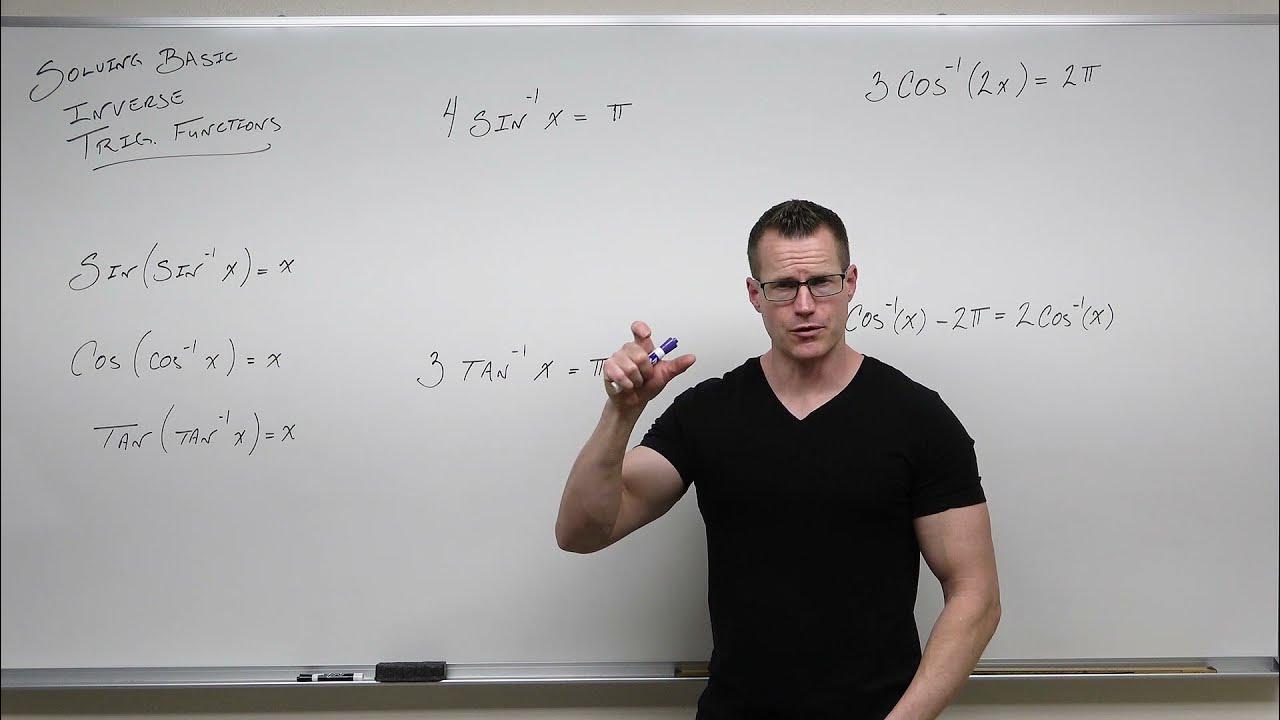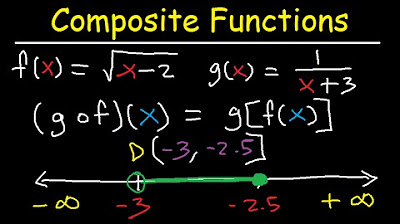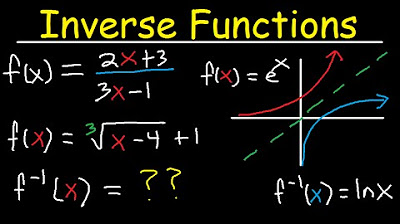Verifying Inverse Functions | Precalculus
TLDRThis video tutorial explores the concept of inverse functions, demonstrating how to determine if two functions are inverses by showing that their composition results in the identity function. It walks through several examples, including squaring and square root operations, and provides step-by-step solutions to verify if functions are inverses by composition and by finding the explicit inverse function. The video also includes a practice problem involving complex fractions and concludes with examples that illustrate both inverse and non-inverse relationships between functions.
Takeaways
- 🔍 To determine if two functions are inverses, one must show that the composition of the functions, f(g(x)) and g(f(x)), both equal x.
- 📚 The first example demonstrates that the functions f(x) = x^2 + 5 and g(x) = √(x - 5) are inverses because f(g(x)) and g(f(x)) simplify to x.
- 📝 The second example with f(x) = 3x + 8 and g(x) = 8x^2 - 3 shows that they are not inverses as f(g(x)) does not simplify to x.
- 🔄 The third example involves f(x) = 7x + 5 and g(x) = (x - 5) / 7, and it is shown that they are inverses since both compositions equal x.
- 📉 In the fourth example, f(x) = 5/x + 3 and g(x) = 5 / (x - 3) are proven to be inverses through simplification of their compositions.
- 📌 The fifth example with f(x) = 8x + 7 and g(x) = 7/x - 8 does not result in inverse functions as f(g(x)) does not equal x.
- 🧩 The sixth and final example confirms that f(x) = x^3 + 5 and g(x) = ∛(x - 5) are inverses, as their compositions both result in x.
- 📑 The script provides a step-by-step method to verify if functions are inverses by composing them and simplifying the result.
- 📐 An alternative method to confirm inverse functions is by finding the inverse function of f and comparing it to g.
- 📈 The script uses algebraic manipulation to simplify compositions and determine the relationship between functions.
- 📘 The examples given in the script are practical applications of the concept of inverse functions in mathematics.
Q & A
What is the criterion for two functions to be inverses of each other?
-Two functions, f(x) and g(x), are inverses of each other if the composition of the functions in both orders, f(g(x)) and g(f(x)), both equal x.
What is the first pair of functions discussed in the video script?
-The first pair of functions discussed are f(x) = x^2 + 5 and g(x) = √(x - 5).
How does the video demonstrate that f(x) and g(x) are inverses for the first example?
-The video shows that f(g(x)) simplifies to x and g(f(x)) also simplifies to x, confirming that they are inverses.
What is another method to verify if two functions are inverses?
-Another method is to find the inverse function of f(x), denoted as f^(-1)(x), and check if it is the same as g(x).
What is the second pair of functions discussed in the video script?
-The second pair of functions discussed are f(x) = 3x + 8 and g(x) = (8x^2 - 3)^(1/2).
Why are the functions f(x) = 3x + 8 and g(x) = (8x^2 - 3)^(1/2) not inverses of each other?
-The functions are not inverses because f(g(x)) does not simplify to x, indicating that g(x) is not the inverse of f(x).
What is the third pair of functions discussed in the video script?
-The third pair of functions discussed are f(x) = 7x + 5 and g(x) = (x - 5)/7.
How does the video show that f(x) = 7x + 5 and g(x) = (x - 5)/7 are inverses?
-The video demonstrates that both f(g(x)) and g(f(x)) simplify to x, confirming that they are inverses.
What is the process of finding the inverse function of f(x)?
-To find the inverse function, you replace x with y in the equation y = f(x), then solve for y.
What is the fourth pair of functions discussed in the video script?
-The fourth pair of functions discussed are f(x) = 5/x + 3 and g(x) = 5/(x - 3).
How does the video demonstrate that f(x) = 5/x + 3 and g(x) = 5/(x - 3) are inverses?
-The video shows that both f(g(x)) and g(f(x)) simplify to x, confirming that they are inverses.
What is the fifth pair of functions discussed in the video script?
-The fifth pair of functions discussed are f(x) = 8x + 7 and g(x) = 7/x - 8.
Why are the functions f(x) = 8x + 7 and g(x) = 7/x - 8 not inverses of each other?
-The functions are not inverses because f(g(x)) does not simplify to x, indicating that they do not cancel out to the identity function.
What is the sixth and final pair of functions discussed in the video script?
-The sixth pair of functions discussed are f(x) = x^3 + 5 and g(x) = ∛(x - 5).
How does the video show that f(x) = x^3 + 5 and g(x) = ∛(x - 5) are inverses?
-The video demonstrates that both f(g(x)) and g(f(x)) simplify to x, confirming that they are inverses.
Outlines
🔍 Verifying Inverse Functions Through Composition
This paragraph explains how to determine if two functions, f(x) and g(x), are inverses of each other. The process involves checking if the composition of the two functions, f(g(x)) and g(f(x)), both result in the original variable x. The example functions given are f(x) = x^2 + 5 and g(x) = √(x - 5). After substituting g(x) into f(x) and simplifying, it's shown that f(g(x)) = x. Similarly, substituting f(x) into g(x) confirms that g(f(x)) = x, proving that the functions are indeed inverses. An alternative method is also discussed, which involves finding the inverse function of f(x) by replacing x with y and solving for y, resulting in the same function g(x). This confirms that f(x) and g(x) are inverses.
📚 Analyzing Function Inverses with Algebraic Manipulation
The second paragraph explores whether different pairs of functions are inverses by algebraically manipulating their compositions. The first pair, f(x) = 3x + 8 and g(x) = 8x^2 - 3, is shown not to be inverses because f(g(x)) does not simplify to x. The second pair, f(x) = 7x + 5 and g(x) = (x - 5)/7, is confirmed to be inverses as both compositions f(g(x)) and g(f(x)) simplify to x. The process involves substituting one function into the other and simplifying to check for the identity. The inverse of f(x) is also calculated to verify that it matches g(x), reinforcing the conclusion that the functions are inverses.
📉 Examining Additional Examples of Function Inverses
This paragraph continues the theme of determining if given functions are inverses by examining additional examples. The first example involves functions f(x) = 5/x + 3 and g(x) = 5/(x - 3), where both compositions f(g(x)) and g(f(x)) simplify to x, confirming they are inverses. The second example features f(x) = 8x + 7 and g(x) = 7/x - 8, which are not inverses as f(g(x)) does not equal x. The final example presents f(x) = x^3 + 5 and g(x) = ∛(x - 5), which are shown to be inverses through the same composition process. Each example illustrates the method of substituting and simplifying to determine the relationship between the functions.
Mindmap
Keywords
💡Inverse Functions
💡Function Composition
💡Square Root
💡Square
💡Cube Root
💡Cube
💡Distributive Property
💡Simplifying Expressions
💡Identity Function
💡Inverse Function Calculation
💡Complex Fractions
Highlights
Introduction to the concept of showing two functions are inverses of each other.
The method involves verifying if the composition of two functions equals the original variable x.
First example: f(x) = x^2 + 5 and g(x) = sqrt(x - 5) are tested for being inverses.
f(g(x)) simplifies to x, indicating a potential inverse relationship.
g(f(x)) also simplifies to x, confirming f and g are inverses.
An alternative method is to find the inverse function of f and compare it with g.
Second example: f(x) = 3x + 8 and g(x) = 8x^2 - 3 are not inverses as f(g(x)) does not equal x.
Third example: f(x) = 7x + 5 and g(x) = (x - 5)/7 are shown to be inverses.
Verification of inverse relationship by showing f(g(x)) and g(f(x)) both equal x.
Finding the inverse of f by algebraic manipulation confirms it matches g(x).
Practice problem presented: Determine if f(x) = 5/x + 3 and g(x) = 5/(x - 3) are inverses.
Multiplication strategy used to simplify f(g(x)) to x, indicating potential inverses.
g(f(x)) simplifies to x, confirming f and g are inverses for the practice problem.
Example with f(x) = 8x + 7 and g(x) = 7/x - 8 shows they are not inverses as f(g(x)) does not equal x.
Final example: f(x) = x^3 + 5 and g(x) = cube root(x - 5) are tested for inverse relationship.
f(g(x)) simplifies to x, and g(f(x)) also simplifies to x, confirming they are inverses.
Transcripts
Browse More Related Video

Functions

Introduction to Inverse Functions

How to Solve Basic Inverse Trigonometric Functions (Precalculus - Trigonometry 20)

Composite Functions Domain Fractions & Square Roots / Radicals - Inverse Functions & Graphs

Inverse Functions

Inverse Functions - Domain & range- With Fractions, Square Roots, & Graphs
5.0 / 5 (0 votes)
Thanks for rating: